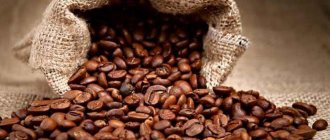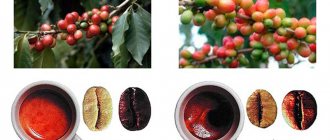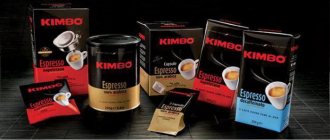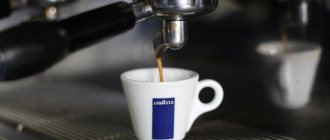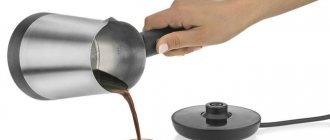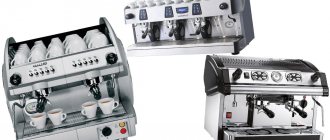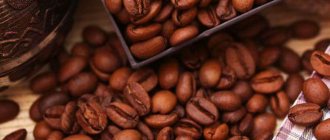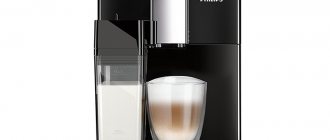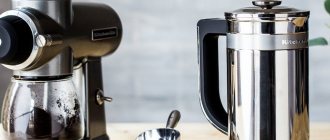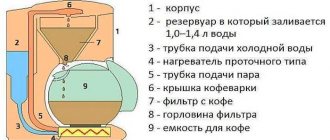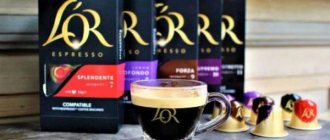Arabica or Robusta, what's the difference?
One of the fundamental characteristics is the ratio of Arabica to Robusta. These are different types of coffee beans.
Arabica gives almost all the flavor shades. Robusta – for richness, bitterness, strength.
The caffeine content in robusta is on average 2 times higher than in arabica. Robusta has no sourness. Robusta is also responsible for the height of the cream foam, so robusta is usually added to espresso mixtures - with it the foam is higher. I have specialized material about robusta.
Arabica can have many shades and facets, differences in the country of origin (terroir, climate in which coffee trees grow), processing of green beans, and roasting. By the way, who didn’t know, coffee is a berry. The higher the variety grows, the denser the grains, the richer the taste, the greater and more varied the sourness. By the way, sourness gives variation in taste, although in Russia, as a rule, they don’t like it.
100% Arabica means that there is relatively little caffeine in the mixture, but there is a lot of flavor variability. To highlight some specific shades (citrus, cocoa, floral notes) you need to switch to single varieties. What it is?
Monosort is grains collected in one country, on a specific territory, plantation. And therefore, in one more or less uniform climate with characteristic taste incarnations. Monosort, with rare exceptions, is only Arabica; the pack must contain beans from the same harvest.
For example, grains from Kenya, Ethiopia and Mexico have the greatest sourness. Soft berry sourness with a peppery hint from Jamaica. Brazil – roasted nuts and cocoa. Vietnam and Uganda – dark chocolate. Arabica beans from Cuba, the Dominican Republic and a separate variety from India, “Monsoon Malabar,” are considered the least acidic. In the latter, the sourness is literally “eroded” by the strong monsoon winds to which the coffee is exposed.
Personally, in the case of automatic coffee machines, I am more impressed by mixtures in the ratios 90/10 – 70/30. For espresso from carob coffee makers with single-bottom baskets, it is better to use 100% Arabica coffee. Funnels/Aeropress/drip coffee makers – also only Arabica.
There are also nuances in the grain size (screen), the initial quality of a specific green raw material (the number of defects per sample, “grade”), but this, as a rule, is no longer so relevant for buyers of automatic coffee machines (although it still has some impact on the taste in a cup) and is beyond the scope of this material.
If you want to buy a few different coffee blends immediately after purchasing a coffee machine in order to decide on “your” bean, then there used to be a good inexpensive option - take several packs of different blends from Lavazza. Lavazza Crema e Gusto is a composition of 30% Arabica and 70% Robusta, classic Italian espresso, with a strong bitterness, but for Russian tastes it can be bitter if you are not used to it. Crema e Aroma – a little “weaker” – 80/20. Caffe Espresso and Qualita Oro are different blends of pure Arabica. That is, with more sourness. But in recent years, Lavazza has seriously lost ground. In general, I personally consider all store-bought coffee to be second-class. I will repeat once again: you need to drink freshly roasted. However, among the store-bought and widely distributed brands they keep the Jardin brand (especially varieties with names for specific countries, such as Columbia Supreme), Paulig (exclusively for its promotional price, which tends to 600 rubles/kg), Julius Meinl, Bushido (this brand might even be in the big league of store-bought coffee, not far from Illy).
So, to understand your preferences as a first approximation - sour-balanced-bitter - it is better to take a sample set of different freshly roasted coffee. Such sample boxes are offered, for example, by Tasty Coffee, Bravos, Neva (in all cases the promo code 101KOFE , giving from 10 to 20% discount).
Recipe for “Italian espresso”: strong, invigorating, thermonuclear charge
By the way, if you don’t like bitterness (read: robusta), perhaps you just haven’t tried good blends with it.
Then, for an experiment, I can recommend buying Caffe Selezione Nobile Espresso from Saeco (well, not from them, of course, this is repackaged coffee under the Saeco brand from a small Italian factory). This is one of the striking examples of “factory” coffee, which on a home automatic coffee machine produces espresso, similar to the one that is loved and prepared in Italy itself using professional coffee horns. They respect mixtures with Robusta and know a lot about them (and know how to prepare them). The shop was closed, Saeco no longer supplies this coffee to us. Then another option is to try a good blend with Robusta. It’s not so easy to find a ready-made composition, so that they don’t skimp on robusta (well, that is, they don’t use the most shameful one), and Arabica without pronounced sourness, above-medium roast. Therefore, I can suggest making this mixture yourself:
- You buy 1 kilogram of a mixture codenamed “Black Candy” - 100% Arabica from Brazil and Colombia, dark roasted.
- Buy 250 grams of 100% robusta from Uganda.
- Pour everything into a large bowl, a plastic 5-liter bottle of clean water works well, close and mix evenly. As a result, you get a freshly roasted, balanced Italian-style blend of “80% Arabica + 20% Robusta.”
- It is better to set the grinding not to minimum (there will be too much bitterness), but closer to medium; I do not recommend pouring more than 30 ml. The temperature in all machines except Delonghi is the highest; in Delonghi it is better to cook on medium.
Types of coffee
classifications of coffee beans, but it all starts with the varieties. More precisely, what we used to call coffee varieties - Robusta, Arabica, Excelsa and Liberica - are not actually varieties. We are talking about varieties of coffee trees, and their beans, in turn, are divided into many varieties.
Arabica
The scientific name of the tree is Coffea arabica . Its harvest accounts for more than 70% of all coffee produced in the world. The berries are red in color, but towards the end of ripening they turn purple. The length of the berry is up to one and a half centimeters . More than five hundred varieties of Coffea arabica are grown on an industrial scale. The most popular are about 40 varieties , but in fact, the list is much larger. The best varieties are Maragogipe, Bourbon and Typica.
Robusta
The Latin name of the tree is Coffea Canephora . The drink itself is not as aromatic as Arabica, but its tonic properties are better. In addition, Coffea Canephora is not as delicate as the Arabian tree, not as fastidious and more resistant to parasites and diseases. Trees also differ in geographical preferences. Thus, they feel comfortable at an altitude of up to 900 meters above sea level and react normally to both temperature changes and changes in precipitation levels.
The best varieties of Robusta are Congensis, Conillon du Brasil, Quilu, Nanu and Java Ineac. The berries ripen for almost a year, and Robusta blooms at random intervals. The downside is that the drink has a strong taste. Most often it is used in various blends, but Italian espresso, beloved by millions, without robusta is simply unthinkable: it turns out invigorating and with thick foam.
Liberica
The Latin name of the tree is Coffea liberica . It was discovered 300 years ago in Liberia. Today it grows in central and western Africa, the Seychelles, the Philippines, Indonesia, South America and more. The trees and their berries themselves are large and are not susceptible to diseases, except for some mycoses. The quality of the drink leaves nothing to be desired: although it has a strong aroma (stronger than Arabica), Liberica has a weakly expressed taste. However, it is actively used in various mixtures.
Excelsa
The Coffea Dewevrei tree is considered a variety of Liberica. In nature it reaches 20 meters. On plantations they are pruned so that their height does not exceed one and a half meters . Many connoisseurs of the invigorating drink simply do not understand Excelsa, considering its taste too fruity. But mixtures of Excelsa and Arabica are refined and delicate. But it’s good if the amount of Excelsa in blends does not exceed 23% , otherwise its taste will come first. However, Excel has no industrial significance.
Washed or natural, dry? Methods of processing coffee, how it affects taste
This information is “second level” and is applicable only for freshly roasted beans, since such details are simply not written on store packaging. Almost all roasters indicate what kind of processing the coffee berry has undergone. This processing is carried out locally immediately after harvest, either by the farmers themselves or by coffee cooperatives/exporters. Roughly speaking, “processing” is removing the grain from the berry. In total, the original berry has 6 layers: peel, pulp, pectin layer (muselage), parchment shell (pachment), silver skin (silverskin) and grain.
There are two classic, most common treatments and quite a few “experimental” ones. Different methods require different time, effort, money, and the dryness/humidity of the environment and the availability of water have a big influence. The choice of method was initially based on the climatic characteristics of the coffee growing region, economy, and infrastructure. More recently, taste has begun to influence the choice of processing, because it directly depends on it, and manufacturers are paying more and more attention to this. However, processing is still typical for the country as a whole. For example, in Colombia almost all coffee is “washed”. All roasters have classic treatments:
- Dry/natural are synonyms. The grain is dried as is, right in the berry, along with the pulp. This method is suitable for dry climates and requires much less water. For the consumer, it is notable for its lower acidity and greater sweetness - sugars from the pulp remain in the grain. Taste descriptors contain more sweet fruits, cocoa, chocolate, vanilla. The body of the drink, all other things being equal, turns out to be denser than from similar washed grains.
- Washed/wet processing . Drying takes place in a parchment shell (pachment), the skin, pulp, and muselage are removed. The skin is removed by depulpation. The pulp is removed by fermentation and washed off with water. Some of the sugars simply have time to dissolve in water, and the grain, deprived of pulp during the drying process, begins to prepare for germination, because of this, metabolic changes occur in it with the formation of amino acids. As a result, the taste is purer and more acidic, and the descriptors are dominated by berries and flowers, the aroma is more complex, the body of the drink is lighter and more drinkable.
There are many experimental treatments, but they are much less common: honey (honey - honey (English), before drying, only the skin and part of the pulp are removed, example from Torrefacto), half-washed (all the pulp is removed, but muselage remains, example from NEVA), vet -hull/giling-basah (these are synonyms, the parchment shell is also removed before drying, the method is typical for Indonesia, an example is from Bravos), anaerobic fermentation (during washed processing, the pulp is removed in water tanks without access to oxygen, here is a typical example from Tasty) etc. Everyone can get to experimental treatments themselves if they deem it necessary
